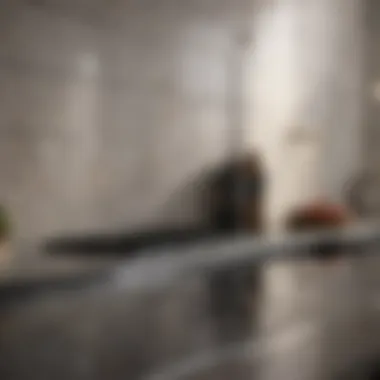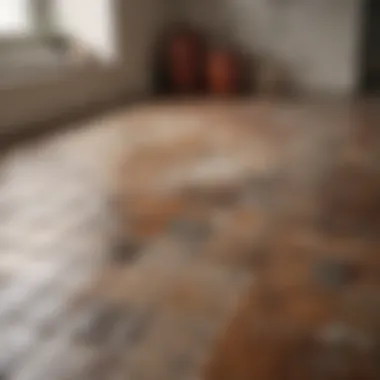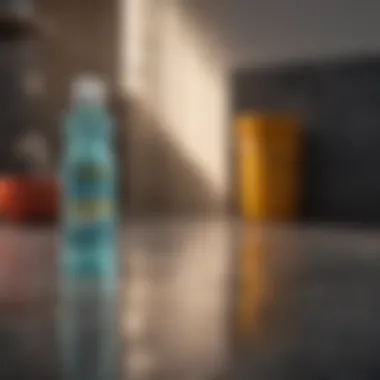Effective Methods for Cleaning Kitchen Tiles


Intro
Cleaning kitchen tiles effectively is crucial for maintaining a hygienic and aesthetic living space. Kitchen tiles endure various forms of grime, from grease splatters to water stains. Understanding how to address these challenges can enhance not only the appearance of your kitchen but also its functionality.
Importance of Tile Maintenance
The kitchen is one of the most frequently used areas in a home. As a result, it faces dirt and staining regularly. Maintaining clean tiles prevents the accumulation of grime, which can become harder to remove over time. Moreover, regular cleaning extends the lifespan of your tiles, keeping your kitchen looking new longer.
Key Points to Discuss
- Identify Tile Types: Different tiles, such as ceramic or porcelain, have unique cleaning needs. Understanding these differences is essential for effective cleaning.
- Choosing the Right Products: Selecting appropriate cleaning products can make the task easier and more efficient. We’ll cover product recommendations suitable for various tile types.
- Cleaning Techniques: Simple methods using household items or specialized cleaners will be outlined in detail, ensuring you can tackle even the toughest stains.
- Maintenance Tips: Strategies to keep your tiles clean routinely will be shared, making ongoing maintenance easier.
Equipped with the right knowledge, you will be able to create a clean and welcoming kitchen environment.
Prologue to Tile Cleaning
Cleaning kitchen tiles is an essential task that contributes significantly to maintaining hygiene in one of the most frequently used spaces in the home. Tiles, particularly in kitchens, endure daily exposure to spills, grease, and food debris. Over time, these contaminants may lead to a buildup of grime, resulting in not just an unsightly appearance but also potential health hazards.
The importance of effective tile cleaning goes beyond aesthetics. Regular and thorough cleaning helps to preserve the integrity of the tiles, preventing long-term damage that can arise from neglect. Also, clean tiles contribute to a healthier living environment, reducing the risk of mold and bacteria that thrive in dirty conditions.
Homeowners and party hosts alike benefit from understanding proper tile cleaning methods. Whether it is preparing for a gathering or simply maintaining a welcoming atmosphere, clean tiles reflect care and attention to one's living space. It is crucial to consider various factors, such as the type of tile material, the nature of the stains, and the most effective cleaning methods applicable to different situations.
In this article, readers will find comprehensive guidance on cleaning techniques tailored to specific tile types, ensuring a targeted approach for successful results. By knowing different methods and products available, homeowners can achieve optimal cleanliness and prolong the lifespan of their kitchen tiles.
"A clean kitchen is a happy kitchen." - While this saying might seem simple, it encapsulates the essence of why tile cleaning deserves attention and dedication.
Understanding Different Tile Materials
Understanding the different types of tile materials is essential when engaging in cleaning methods. Each material has unique characteristics that influence the cleaning approach required. Knowledge in this area provides clear insights into effective and safe methods for maintaining the integrity and appearance of tiles. The benefits of understanding tile materials include protection against damage, informed choices for cleaning products, and strategies tailored to specific surfaces.
Ceramic Tiles
Ceramic tiles are a popular choice for kitchens due to their durability and ease of maintenance. They are made from clay and other natural materials, then fired at high temperatures. This process results in a sturdy surface that is resistant to moisture and staining. To clean ceramic tiles, one can use a mixture of water and an all-purpose cleaner.
For tougher stains, a mild detergent may be effective. It is important to avoid acidic cleaners as they can dull the finish over time. Regular cleaning will keep the tiles looking new, and sealing the grout lines will prevent them from becoming discolored.
Porcelain Tiles
Porcelain tiles are similar to ceramic but are denser and less porous. This makes them ideal for high-traffic areas. Porcelain tiles are more resistant to water and stains, which simplifies cleaning. The application of a pH-neutral cleaner is recommended for everyday maintenance.
In case of tough grime or stains, using a specialized porcelain cleaner can be beneficial. Just like with ceramic tiles, it is wise to avoid harsh chemicals that could lead to damage. Sealing the grout is also crucial for preserving the tile's appearance.
Natural Stone Tiles
Natural stone tiles such as marble, granite, and slate bring a unique beauty to kitchens. However, they require specific care to maintain their appeal. Each type of natural stone has its own cleaning requirements. Generally, it is advisable to use a stone-safe cleaner that won’t etch or damage the surface.
Natural stones are usually susceptible to staining, especially if spills are not cleaned promptly. Sealing these tiles can prevent liquids from penetrating the surface. Regular cleaning with a soft cloth and warm water is often sufficient to keep them in good condition.
Understanding the characteristics of your tile material helps prevent costly mistakes and ensures longevity in both appearance and functionality.
Assessing the Condition of Tiles
Before initiating any cleaning process, it is crucial to assess the condition of your tiles. This step not only helps in determining the appropriate cleaning methods but also reveals any underlying issues that may demand more attention. Evaluating the state of your tiles can yield significant benefits, such as preventing further damage and extending the life of your tile surfaces. If not done properly, cleaning efforts could exacerbate existing problems or lead to ineffective results.


Identifying Stains and Grime
Identifying the types of stains and grime on your kitchen tiles is essential for several reasons. First, different materials react differently to various cleaning agents. For instance, ceramic tiles may tolerate stronger detergents, whereas natural stone tiles can be damaged by acidic substances. By recognizing the specific stains present, you can select an effective cleaning solution tailored to the need.
Several common stains and grime types might appear on kitchen tiles:
- Food spills: These can leave behind grease or stains from sauces.
- Water spots: Particularly on natural stone, hard water can leave deposits.
- Mold and mildew: Often found in damp spaces, they need specialized treatment.
Taking the time to examine tiles closely is vital. Look for discolorations, chipping, or any areas where grout has eroded. Such signs may indicate deeper issues, such as moisture intrusion, requiring further investigation.
"Effective cleaning starts with understanding what you're up against."
Through this assessment, you can tailor your cleaning strategy, ensuring a more thorough and effective approach overall.
Essential Cleaning Supplies
The choice of cleaning supplies plays a crucial role in achieving the desired results when cleaning kitchen tiles. It is essential to select appropriate products that cater to the tile material and the type of stains present. Using the right supplies can significantly enhance cleaning efficiency and minimize damage to surfaces. An understanding of key cleaning materials can lead to a more systematic approach, ensuring that homeowners are well-equipped to maintain a clean kitchen environment.
Detergents and All-Purpose Cleaners
Detergents and all-purpose cleaners are foundational in tile cleaning. These products are formulated to break down grease, grime, and stains effectively. They often contain surfactants that lift dirt, making it easier to wipe away. When selecting a detergent, consider its compatibility with your tile type. For example, a stronger cleaner might be suitable for ceramic tiles but could harm the finish of natural stone.
The benefits of using a quality detergent include:
- Efficiency: These cleaners often require less scrubbing compared to natural solutions.
- Versatility: All-purpose cleaners can be used on various surfaces, including countertops and appliances.
- Time-saving: Effective detergents often reduce the time needed for cleaning tasks.
However, it is crucial to read labels carefully to avoid harsh chemicals that might damage tiles or harmful residues.
Natural Cleaning Solutions
Natural cleaning solutions present an eco-friendly alternative to traditional chemicals. These solutions often include vinegar, baking soda, and lemon juice. They are effective against light stains and odors, making them popular for homeowners who prefer sustainable options. Natural cleaning solutions have several advantages:
- Safety: They are less likely to cause adverse reactions for those sensitive to fumes or chemicals.
- Cost-effective: Common household ingredients can serve as effective cleaners, reducing expenses.
- Environmental impact: Using organic materials contributes to a healthier planet.
When using natural cleaners, it is vital to test them on a small, inconspicuous area first to ensure they do not affect the tile's finish.
Scrubbing Tools and Equipment
The scrubbing tools selected during the cleaning process can make a significant difference in the effectiveness and ease of tile cleaning. Various tools serve different purposes, and understanding how to use them properly is essential.
Key tools include:
- Soft-Bristled Brushes: Ideal for preventing scratches on delicate tile surfaces.
- Microfiber Cloths: Useful for both application of cleaners and drying.
- Mops with Scrubbing Pads: Good for larger areas, providing efficient coverage.
Equipping yourself with the proper tools not only improves cleaning performance but also addresses specific issues, such as preventing tile damage.
"Choosing the right cleaning supplies is not just about immediate results but investing in the longevity and appearance of your kitchen tiles."
Each cleaning situation may require different supplies, which underscores the importance of having a well-rounded selection of cleaning materials on hand.
Step-by-Step Cleaning Process
Cleaning kitchen tiles is not simply about using the right products; it requires a well-planned approach. This section outlines the step-by-step cleaning process, focusing on organization and technique. A methodical process ensures that all areas receive attention. Moreover, it minimizes the chances of wasting time and resources. By following this structured guide, homeowners can achieve the best results with their cleaning efforts.


Preparation of the Cleaning Area
Preparation is the first step in any cleaning process. To begin, it is crucial to clear the area of items that may obstruct the cleaning flow. Remove pots, pans, and any furniture that may be in the way. Not only does this create a more spacious environment, but it also protects these items from potential damage due to cleaning products.
Once cleared, it is wise to cover surfaces that should not get wet or exposed to cleaners. This could include adjacent countertops and appliances. Using plastic sheets or towels can prevent accidental spills from causing additional clean-up tasks later. Finally, ensure the area is well-ventilated. Open windows and doors, as some cleaners may release harmful vapors.
Pre-Cleaning Actions
Before applying any cleaners, pre-cleaning actions are essential. Dust and sweep the tiles to remove loose debris and food particles. This initial step can drastically improve the effectiveness of your cleaner. After sweeping, mopping with warm water is recommended. Warm water can loosen grime and stains, making the following steps much easier.
It is also beneficial to assess any tough stains that may require special attention. Identifying these areas upfront allows for targeted actions. If any areas are particularly dirty, consider using a degreaser or specialized stone cleaner before the main cleaning process begins.
Applying Cleaners
Once pre-cleaning is complete, it is time to apply cleaners. For tile surfaces, all-purpose cleaners or detergents usually work best. Apply the cleaner according to the manufacturer’s instructions. Spraying a reasonably even layer across the surface ensures that all areas are treated effectively.
Allow the cleaner to dwell for a specified time. Typically, five to ten minutes is sufficient. This dwell time enables the product to penetrate grime and stains more effectively.
Effective Scrubbing Techniques
After the cleaner has set, effective scrubbing is vital. Use the appropriate tools based on the tile material. A soft-bristle brush works well for ceramic tiles, while a microfiber cloth is often adequate for porcelain. For natural stone tiles, it is best to use a non-abrasive sponge or cloth to avoid damaging the surface.
When scrubbing, use moderate pressure. Over-scrubbing can lead to damage, especially on softer tile surfaces. Focus on small sections at a time, ensuring that each area receives adequate attention. Pay special care to grout lines, where dirt tends to accumulate.
Rinsing and Drying
Concluding the cleaning process involves rinsing the tiles thoroughly. Use clean, warm water and a mop or cloth. This step is important to remove any leftover cleaner residue that could lead to a slippery surface or attract more dirt. Once rinsed, allow the tiles to air dry or use a clean towel to dry them off.
Make sure to check for any missed spots after drying. If any areas still seem dirty, it may be necessary to repeat the scrubbing process.
"A thorough cleaning process not only revitalizes the appearance of tiles but also extends their longevity, making regular maintenance easier."
By adhering to this step-by-step guide, cleaning kitchen tiles becomes a manageable task. Following these methods ensures that the tiles remain in good condition while contributing to a cleaner and healthier kitchen environment.
Addressing Stubborn Stains
Stubborn stains on kitchen tiles can be quite frustrating for homeowners. Not only do they detract from the overall appearance of your kitchen, but they can also harbor bacteria and grime, making it essential to address them effectively. This section will discuss the common types of stains found on kitchen tiles, their effective solutions, and when to consider specialized cleaners.
Common Stains and Their Solutions
Stains on kitchen tiles can originate from various sources. Here are common stains and their potential remedies:
- Oil and Grease: Cooking often leads to oily splatters. A mixture of warm water and dish soap is often effective. Alternatively, a paste of baking soda and water can help break down the grease. Simply apply it to the stain, let it sit for a few minutes, and scrub gently.
- Food Stains: Tomato sauce and other vibrant foods can leave noticeable marks. For these, a mix of vinegar and water can work well. Spray lightly on the stain, let it sit, then wipe clean with a cloth.
- Water Stains: Hard water can leave mineral deposits. Using a solution of equal parts white vinegar and water can help to dissolve these deposits effectively.
- Ink and Dye Stains: These are tricky. Rubbing alcohol or hand sanitizer can sometimes lift these stains. Dampen a cloth with either and dab it on the stain, avoiding excessive scrubbing that can damage the tile surface.
- Mold and Mildew: Typically found in damp areas, a mixture of bleach and water can be effective. Mix one part bleach with ten parts water and apply. Ensure proper ventilation, as bleach fumes can be strong.
Using Specialized Cleaners
In some cases, common household solutions may not suffice. Specialized cleaners can be a valuable asset. When selecting these cleaners, consider the type of tile material. Here are some options:
- Acidic Cleaners: These are beneficial for natural stone tiles, as they can help remove hard-water stains, mineral buildup, and some food stains. However, caution is necessary since they can damage certain finishes. Always test in an inconspicuous area first.
- Enzyme Cleaners: These are effective against organic stains like food and grease. They work by breaking down the stains at a molecular level. Apply as directed, and allow sufficient time for the enzymes to act.
- Stone-Specific Cleaners: For natural stone tiles, consider cleaners intended to maintain their finish and prevent etching. High-quality formulations, specifically designed for granite or marble, often yield the best results.
- Disinfectant Cleaners: In high-traffic areas or kitchens, disinfectants can help eliminate bacterial growth, particularly after a cleaning session for mold or food spills.
"Choosing the right cleaner is paramount. Always refer to the manufacturer’s guidelines and do a small test area first."
Effective cleaning of stubborn stains requires persistence. Understanding the stain type and using the appropriate cleaning method can lead to a noticeable difference in tile maintenance. Regular upkeep can minimize the frequency of deep cleans and keep your kitchen looking fresh.


Maintaining Clean Tiles
Maintaining clean tiles is an essential aspect of kitchen care. Over time, dirt, grime, and stains can accumulate, reducing the aesthetic appeal and hygiene of the space. Regular upkeep can prevent the need for more intensive cleaning later on. Keeping tiles clean not only enhances the look of your kitchen but also contributes to a healthier environment.
There are specific benefits to maintaining tile cleanliness. First, it prevents bacteria and mold from taking hold in the grout lines or between the tiles. This is especially important in a kitchen, where food preparation occurs regularly. Second, regular cleaning can protect your investment in tile flooring by prolonging its lifespan. Damage incurred through neglect can lead to costly repairs or replacements.
Additionally, the appearance of your kitchen influences the overall ambiance of your home. A clean kitchen is welcoming and appealing to both family members and guests. Therefore, establishing a routine for tile maintenance can vastly improve your kitchen's functionality and aesthetics.
Regular Cleaning Routines
Establishing a regular cleaning routine for kitchen tiles is crucial. This can be as simple as making daily or weekly cleaning a habit. A light cleaning each day can help maintain the sheen of your tiles. Use a soft broom or vacuum to remove loose debris and dust.
For a deeper clean, consider the following tips:
- Daily Wipe Downs: Use a damp cloth or mop with warm water to wipe down tiles daily. This prevents the buildup of dirt and grime.
- Weekly Cleaning: Dedicate a day to do a more thorough cleaning. You can use an all-purpose cleaner or a natural solution, like vinegar mixed with water, to clean the tiles effectively.
- Monthly Deep Cleaning: At least once a month, invest time in scrubbing the grout lines and removing any heavy stains. A paste of baking soda and water can be effective for tougher spots.
These routines create a manageable way to keep your tiles looking new and fresh without overwhelming effort.
Sealing and Protecting Tiles
Sealing tiles is a critical step in maintaining their integrity and appearance, especially for porous materials. Sealing creates a barrier that protects tiles from stains and spills, making cleanup much easier. Depending on the type of tile, the need for sealing can differ. Porcelain and ceramic tiles often require less frequent sealing compared to natural stone tiles.
To effectively seal your tiles:
- Choose the Right Sealant: For natural stone tiles, a penetrating sealant is ideal. For ceramic and porcelain, a topical sealant can provide added protection.
- Clean Thoroughly Before Sealing: Ensure that tiles are clean and dry before applying sealant. This will help it adhere properly and function effectively.
- Apply a Thin Layer: Use a sponge or brush to apply the sealant evenly. Follow the manufacturer’s instructions regarding application methods and drying times.
- Reapply as Needed: Sealing is not a one-time process. Depending on wear and usage, consider resealing every six to twelve months.
Regular sealing can extend the life of your tiles significantly, making maintenance easier and keeping your kitchen pristine.
When to Seek Professional Help
Cleaning kitchen tiles can sometimes feel like a herculean task. Even with the right tools and techniques, there are situations where the mess is beyond the homeowner's capabilities. Recognizing when to seek professional help is crucial for maintaining the integrity and appearance of your tiles. Professionals possess specialized knowledge, tools, and products that might not be readily available to the average person. This can save time and prevent damage to the tiles.
Tile cleaning professionals have a depth of experience in addressing various cleaning challenges. They know how to handle different types of materials without causing harm. For instance, natural stone tiles require particular care. They may use specific products that are safer and more effective than what a homeowner might find in a local store. Engaging a professional ensures that the job is done correctly the first time, reducing the likelihood of needing follow-up work.
Factors to consider when deciding whether to hire a professional include:
- Severity of the Stains: If the tile stains appear stubborn and do not respond to usual cleaning methods, professional intervention might be necessary.
- Type of Tile: Certain materials can be tricky to clean. For example, tiles made from delicate materials like marble can be easily damaged.
- Time Constraints: If you have a busy schedule, the efficiency of a professional cleaner can free up valuable time.
- Health Concerns: Extensive mold or bacteria growth can pose health risks. Professionals can handle these safely and effectively.
"Sometimes asking for help is the best choice you can make."
Identifying Complex Problems
Recognizing complex issues with kitchen tiles is the first step in determining if professional help is needed. Here are some indicators to be aware of:
- Deep-Seated Stains: If stains penetrate into the tile or grout and ordinary cleaning methods do not work, this signals a deeper issue.
- Cracks and Chips: Physical damage like cracks or chips is not only unappealing but can worsen if not addressed.
- Mold Growth: If you observe mold or mildew in the tile grout, this can be challenging to remove, especially in moist areas.
- Discoloration of Grout: If the grout has changed color, it may indicate long-term staining or exposure to harsh chemicals.
Homeowners should assess the situation thoroughly. Sometimes, the solution might be simple. Other times, however, an expert touch can yield the best results. Identifying these issues early can prevent more significant problems later on.
Closure
One of the key elements discussed is understanding the different types of tile materials. Each type, be it ceramic, porcelain, or natural stone, demands a tailored cleaning approach. This specificity assures that the integrity of the tiles is preserved while removing grime effectively.
The article further highlighted the importance of having the right cleaning supplies. From standard detergents to natural cleaning solutions, using proper products can enhance cleaning efficiency. Scrubbing tools likewise play a crucial role. Choosing the appropriate tool for the task can yield better results with less effort.
We also outlined a step-by-step cleaning process. These systematic actions not only streamline the task but also ensure that no areas are overlooked. Effective scrubbing techniques and proper rinsing practices can dramatically improve tile appearance and longevity.
Moreover, addressing stubborn stains with specialized cleaners can make a significant difference in restoring the original look of your tiles. By identifying common stains and their solutions, homeowners can equip themselves with the knowledge needed for even the toughest cleaning challenges. Maintaining a routine cleaning schedule also contributes to the long-term maintenance of kitchen tiles, preventing buildup that can lead to more severe problems.
Finally, knowing when to seek professional help is a valuable takeaway from this guide. Complex issues may arise that require expert intervention, and recognizing these situations can save time and expense.
In summary, regular tile cleaning and maintenance are not mere chores but essential processes that ensure a sanitary and appealing kitchen. Implementing the methods discussed will not only render spaces more inviting but also promote a healthier living environment.



